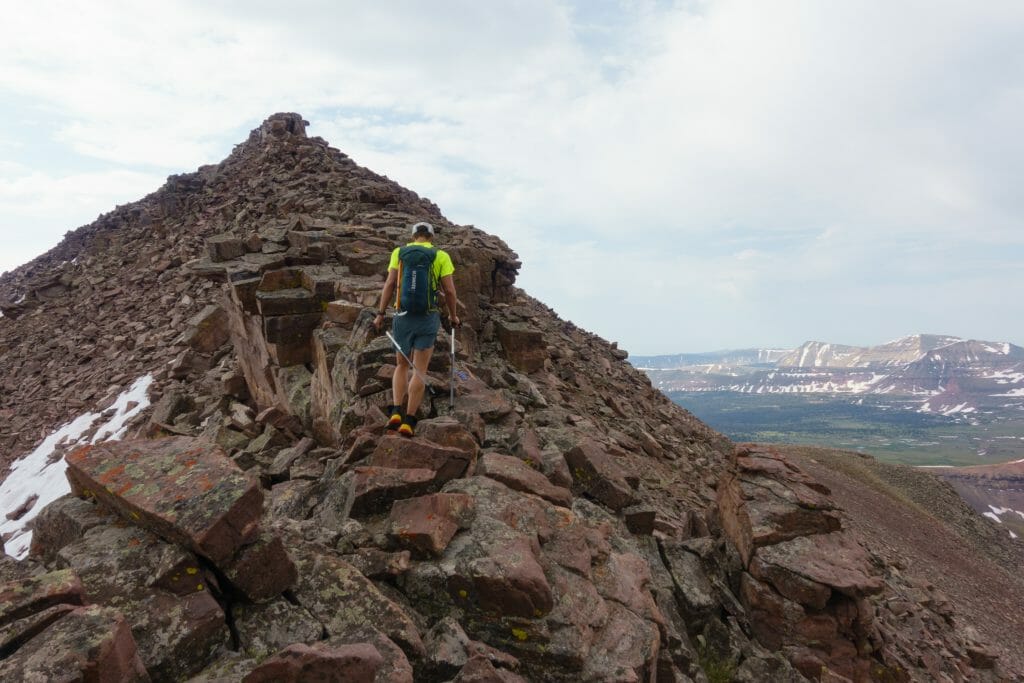Anticipation is an interesting thing, both exciting and stressful. It also grows and builds as the moment nears. Two days before our planned departure my anticipation was peaking. I was sitting among a jumbled pile of gear in the kitchen trying to determine what equipment and food would be necessary for Jared Campbell and me to climb all 19 of the 13,000-foot peaks in Utah in a single push. This had been done before, by Tom Goth and Jason Dorais, a few years before. We hoped to go faster than they had, and had been planning for over a year.
As I sorted and re-sorted the gear, I felt calm and confident, which is not the usual for me. Typically as I pack for a large race or adventure I feel anxious, nervous. This calm struck me as unusual, and I sat back to try to determine why. There were several ideas that popped in to my head, but what it really boiled down to was preparation. Scott Johnston, who has been at the helm of my training for nearly two years, and I agreed on this particular goal the previous October.
There had been months of specific volume and strength building. Dozens of carefully focused workouts that included intervals of various types, back-to-back longer efforts, and most important for me, focused recovery. I am convinced that what most ultrarunners and mountain athletes fail at in training is adequate recovery between training sessions and events. Thankfully Scott keeps close watch and is often the voice of sound scientific reason when I try to take on too much.
A series of key workouts had been included into my training for the first time. Scott calls them LME (local muscular endurance), a form of strength training that is magic for me. The workouts are a weighted interval, done in a sequential order that would leave my legs quivering at the end. This was a new type of stimulus for me—my legs often begged for mercy—but I started seeing rapid gains from the workouts, and as they progressed so did I. I felt very strong ascending, and did not tire easily or quickly during very long mountain runs.
Staring at the pile of gear and knowing that my training had been thorough and thoughtful brought a smile to my face. A smile of confidence. Eventually I was able to turn the chaos of gear into the right selection of equipment, clothing, and food that I would need.
The next day I met Jared in SLC and we were driven to our drop-off in the Uintas by Jared’s co-worker Dave. We slept as near the trailhead as we could, hindered by a deep stream crossing that kept us from getting the final mile or so the the actual trailhead. The following morning, with slight hints of dawn on the horizon, we set out. Over the next 32 hours and 50 minutes we would summit every 13,000-foot peak in the state of Utah. The vast majority of the 58 miles would be on loose, unstable,, and sketchy talus. As with any effort of this magnitude, both Jared and I experienced some low patches, but I can confidently say that the training and preparation had paid off. Overall I felt strong, and capable.
Jared Campbell and I established a new Fastest Known Time for climbing the 19 Utah 13ers by nearly 4 hours, but that is not what I am happiest about. I am extremely pleased that I went into the mountains that day prepared enough that it was not a sufferfest. The training had prepared my body and mind in such a way that, although very difficult, I realized this success with joy, and that is why I train.
Luke Nelson is a Physician’s Assistant, husband, father of three, and ultrarunner proudly supported by Patagonia, La Sportiva, Zeal Optics, GU Energy, and Uphill Athlete.

